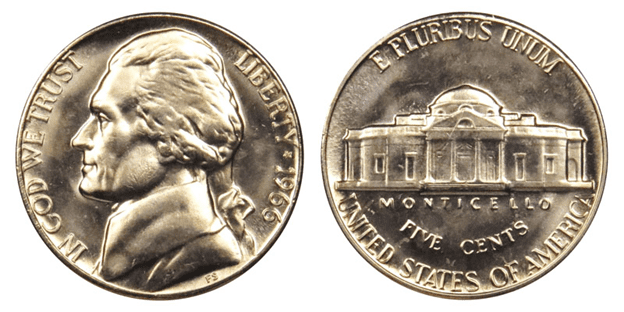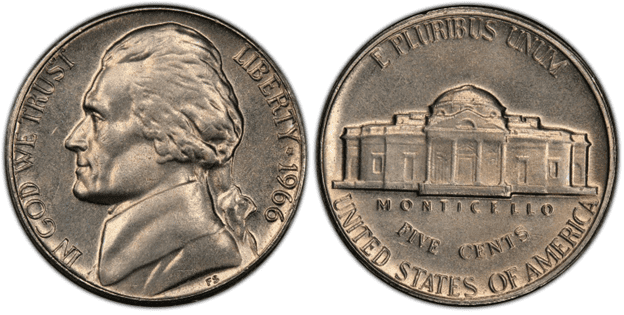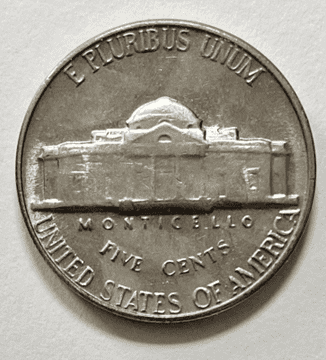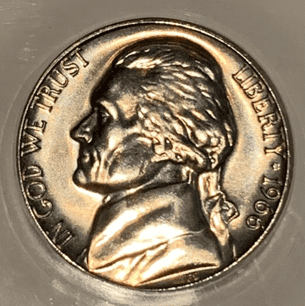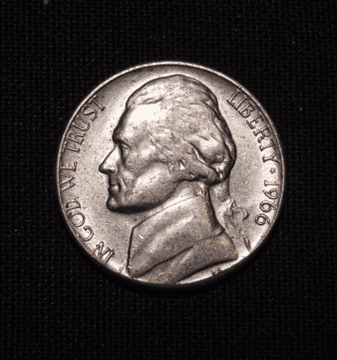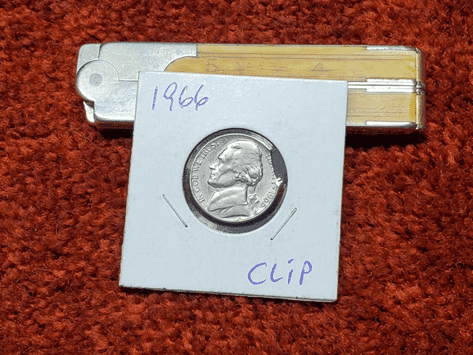What Is the 1966 Jefferson Nickel Made Of?
The 1966 Jefferson nickel is made of 75% copper and 25% nickel. The nickel was referred to as “war nickels” from mid-1942 to 1945. These nickels were composed of 56% copper, 35% silver, and 9% manganese. The US needed to reduce the base metal content of nickel since these metals are key raw materials in producing war equipment.
Here’s a quick look at the specifications of the 1966 Jefferson nickel:
- Value – $0.05
- Mass – 5 grams
- Diameter – 21.21 mm
- Thickness – 1.95 mm
- Edge – smooth
- Years of minting – 1866 to present except years 1922, 1932, and 1933
Felix Schlag was the American designer of the Jefferson nickel. He designed the coin after winning the competition held by the US Mint to find a new face for the nickel coin.
Did you know that the US Mint allowed Felix Schlag to add his initials to the coin? However, due to some misunderstanding or oversight, the initials weren’t included. It was only in 1966 that his new initials were added.

photo source: USA Coin Book
The overall design of the 1966 nickel coin is simple. You have Jefferson’s image facing the left. The inscriptions include the following:
- IN GOD WE TRUST
- LIBERTY
- 1966
- FS (designer’s initials)
The reverse side features the front view of the Monticello Mansion, which Jefferson himself designed and built. The inscriptions include the following:
- E PLURIBUS UNUM (American motto, which means “out of many, one.”)
- MONTICELLO
- FIVE CENTS
- UNITED STATES OF AMERICA
Prior to the Jefferson nickel, the nickel is called the Buffalo nickel, which was struck from 1913 to 1938. While the Buffalo design was well regarded and accepted, it was difficult to produce. It has a high rate of die break.
According to the existing law at that time, the Buffalo nickels should be used for at least 25 years. So, even if the US Mint wanted to replace the design, they can’t do it immediately.
After 25 years of using the Buffalo nickel design, Congress moved to replace it with a portrait of Jefferson.
1966 Jefferson Nickel Varieties
The Jefferson nickel had only one standard variety in 1966. Here are the specifications:
Edge: Smooth
Mint Mark: No mint mark
Place of minting: Philadelphia
Year of minting: 1966
Face Value: $0.05 (fifty cents)
Price: $0.05 to $18.00 (or more)
Quantity produced: 156,208,283
Designer: Felix Schlag
Composition: 75% copper and 25% nickel
Mass: 5 grams
Diameter: 21.21 mm
Thickness: 1.95 mm

photo source: PCGS
The 1966-P Nickel was struck in the Philadelphia Mint. At the end of 1966, over 156 million Jefferson nickels were produced. Price would usually range from $0.05 to $18.00. Although, there are 1966 nickels that are thousands of dollars in price.
List Of 1966 Jefferson Nickel Errors
With millions of 1966 Jefferson nickels, it is not surprising to see that there are a few of them that received errors in minting.
Errors usually happen due to problems in the minting equipment. Sometimes, errors happen due to the wrong cutting of planchets. There are also instances when human error is the cause.
Although the US Mint doesn’t want to produce any error coins, collectors are actually excited to find these types of coins. After all, error coins come in various forms. There are rare and unique coins. You never know what you’ll get.
To give you an idea, here’s an example of a 1966 Jefferson coin with doubled die reverse error:

photo source: eBay
If you look closely at the upper outline of the Monticello, especially the dome and roofing, you’ll see there’s a doubling of its details. A doubled die error happens when the die struck the coin twice.
Here’s another example of an error:

photo source: eBay
This error comes with a struck-through error. This happens when the die strikes the coin through a foreign material.
In this nickel, the pigtail of Jefferson seems to fade away:

photo source: eBay
Some errors happen even before the coin is struck. In this error, you’ll see there’s a clip portion of the coin. This happens due to improper cutting of the planchet.

photo source: eBay
How Much Is 1966 Jefferson Nickel Worth Today?
The 1966 Jefferson nickel is $0.05 in face value. The melt value is $0.0570. Even if the face value and melt value aren’t that big, you’ll be surprised to know that some 1966 Jefferson nickels were sold for thousands of dollars.
To give you an idea of their prices, here’s a 1966 Jefferson Nickel values chart:
| Coin | Condition | Grade | Mintage | Value |
| 1966 P Jefferson Nickel | Circulated/mint | Not graded | 156,208,283 | $0.05 to $18.00 |
| 1966 P Jefferson Nickel | Uncirculated/mint | MS-64 | 156,208,283 | $1,260 to $1,725 |
| 1966 P Jefferson Nickel | Uncirculated/mint | MS-65 | 156,208,283 | $4,313 to $11,750 |
As you can see, an MS-65 1966 P Jefferson nickel was sold for $11,750 last January 2016 during an auction held by the Heritage Auctions in Tampa, Florida.
How Does The Grading System Work?
The Sheldon Scale is used by numismatists to provide a numerical value to coins. The Sheldon Scale goes from poor (P-1) to perfect mint state (P-1) (MS-70). Coins were originally evaluated using words to reflect their condition (Good, Fair, Excellent, Etc.). Unfortunately, coin collectors and dealers had different ideas about what each of these terms represent.
Professional numismatists joined together in the 1970s and established CoinGrading standards. These numismatists now assign grades at key places on the seventy-point scale, using the most regularly utilized numeric points in conjunction with the original adjective grade. The following are the most common coin grades:
-
-
- (P-1) Poor – Indistinguishable and probably damaged; if used, must have a date and mintmark; otherwise, rather battered.
- (FR-2) Fair – Nearly smooth, but without the damage that a coin graded Poor often possesses. The coin must have enough detail to be identified.
- (G-4) Fair – Inscriptions have merged into the rims in some areas, and important elements have been mostly erased.
- (VG-8) Very Good- A little weathered, but all of the primary design elements are visible, albeit faintly. There is little if any, central detail left.
- (F-12) Good – The item is very worn, yet the wear is even, and the overall design details stand out clearly. Rims are almost completely isolated from the field.
- (VF-20) Very Fine – Moderately weathered, with some finer features still visible. The motto or all letters of LIBERTY are readable. Both sides of the coin have entire rims that are separated from the field.
- (EF-40) Extremely Fine – Gently used; all gadgets are visible, and the most important ones are bold. The finer details are bold and clear, however, light wear may be seen.
- (AU-50) Uncirculated – Slight evidence of wear on the coin’s design’s high points; may have contact marks; eye appeal should be adequate.
- (AU-58) Uncirculated Choice – Slight traces of wear, no severe contact marks, almost full mint shine, and great eye appeal.
- (MS-60) Mint State Basal – Strictly uncirculated; no indication of wear on the coin’s highest points, but an unsightly coin with reduced luster, visible contact marks, hairlines, and other flaws.
- (MS-63) Mint State Acceptable – Uncirculated, but with contact scratches and nicks, little reduced shine, but otherwise appealing appearance. The strike is weak to average.
- (MS-65) Mint State Choice – Uncirculated with great mint shine, very little contact blemishes, and exceptional eye appeal. The strike is unusually severe.
- (MS-68) Mint State Premium Quality – Uncirculated with superb luster, no obvious contact marks to the naked eye, and exceptional eye appeal. The strike is quick and appealing.
- (MS-69) Almost Perfect Mint State – Uncirculated with perfect brilliance, a sharp and appealing strike, and extremely good eye appeal. A near-perfect coin with minor imperfections in the planchet, strike, and contact markings (seen only under 8x magnification).
- (MS-70) Mint State Perfect – Under 8x magnification, there are no tiny imperfections discernible; the strike is crisp, and the coin is perfectly centered on a beautiful planchet. Rarely seen on a coin, this coin is bright and whole, with original luster and exceptional eye appeal.
-
Where To Buy Or Sell 1966 Jefferson Nickel?
There are different places where you can buy and sell 1966 Jefferson nickels. The quickest way to find Jefferson nickels would be through the Internet. Some of the best platforms would include Amazon, eBay, and Etsy. You can also use social media platforms to find buyers and sellers.
Aside from online, you can visit coin shops or collectors’ hubs. Antique shops might also have 1966 Jefferson nickels. If you are interested, you can try to join auctions. These places are known to offer some of the rarest and most unique 1966 nickels.
Moreover, you can look for clubs or groups of coin collectors in your local area. By joining clubs of like-minded people, you widen your network. This allows you to have a better chance of selling or buying 1966 Jefferson nickels.
FAQs
Is a 1966 nickel rare?
Yes, there are rare 1966 nickels. One example would be the 1966 nickel with full steps. At the time of this writing, PCGS has only certified six 1966 nickels with full steps. Aside from that, nickels with grades of at least MS-64 and above are considered rare since only a few of these coins exist today.
Do nickels have silver?
Nickels struck in mid-1942 and 1945 were composed of 35% silver. Thus, these nickels are often called silver war nickels.
Is 1966 Jefferson Nickel Worth $40000?
It depends. There are extremely rare Jefferson nickels that carry a high premium and collector’s value. It’s worth remembering that 1966 was the first year that the designer’s initials, FS, were added.
According to some sources, Felix Schlag received two special 1966 Jefferson nickels. These two nickels were considered extremely rare and thus, it is most likely that these nickels are priced at $40,000.

